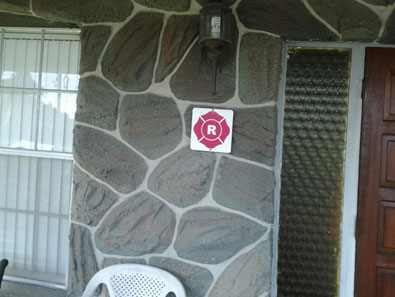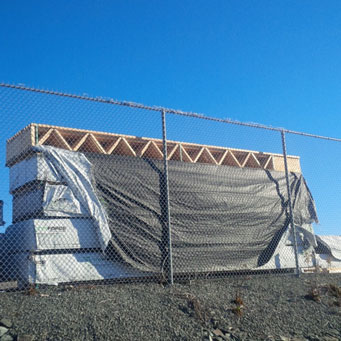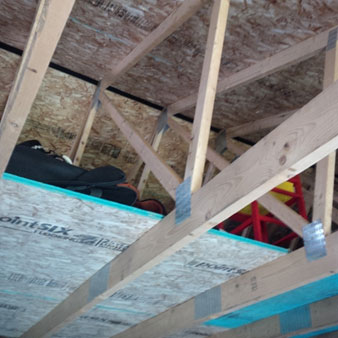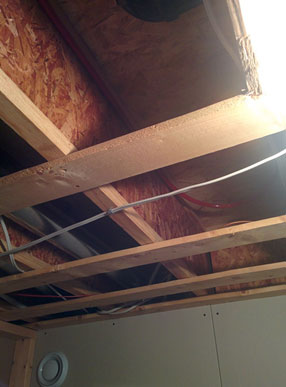
By Bruce Lake
Photos by author unless otherwise indicated
While visiting family in Dunedin, Florida, I noticed that many buildings were marked with a small sign containing the letter “R” and or “F.” Upon closer inspection, I noted that the letters were inside a Maltese cross (see photo 1). My father in-law informed me that the signs were mandated by Florida law. Their purpose was to warn firefighters about the presence of “light-frame truss-type construction.” The letter “R” indicated roof and the letter “F” indicated floor. I thought to myself, “What a simple yet effective way to improve size-up.”

Photo 1. Maltese Cross Sign with letter “R.” Photo by Tom Fidgen.
Size-up is an information-gathering process that firefighters use to assess situations. It works on the principle that accurate information produces better decisions. It is a continuous process that initially occurs prior to the assignment of resources. How, then, does marking a building with a letter improve size-up? Before I can answer that question, you first need some background information.

Photo 2. Solid wood products.
Engineered lumber products, also referred to as lightweight construction, have been replacing traditional or legacy materials for many decades. Historically, materials used in the construction of floor and roof assemblies consisted of solid wood products such as 2 X 8s, 2 X 10s, and 2 X 12s (see photo 2). Engineered lumber products such as I-joists (see photo 3) and parallel chord trusses (see photo 4) enable builders to span greater distances in less time for cheaper costs. Under normal conditions, lightweight materials are as safe and strong as legacy materials. Under fire conditions, however, lightweight materials will fail much quicker than solid wood products.

Photo 3. I-joists.

Photo 4. Parallel cord trusses.
RELATED: Tulsa Fire Department’s Bowstring Truss ID System | Construction Concerns for Firefighters: Trusses | Truss Roof Fire, Wyckoff, New Jersey | Identifying Lightweight Construction
In 2008, Underwriters Laboratories conducted experiments that compared the fire resistive properties of engineered lumber to legacy materials. During the experiments, unprotected legacy materials withstood fire conditions for 18 minutes before collapse. In contrast, unprotected engineered lumber failed after only four minutes. During the experiments, when ½-inch thick generic gypsum board was placed between the lumber and the fire, time to failure increased to 45 minutes for legacy materials and 25 minutes for lightweight. Also in 2008, the National Research Council Canada (NRCC) compared the fire resistive properties of engineered lumber to legacy materials. According to the NRCC, engineered lumber products would reach structural failure 35-60 percent faster than solid wood joist assembly under the same fire conditions.

Photo 4. Lightweight wood trusses.
It is very challenging during the initial chaos of a structure fire to determine whether or not a building contains lightweight materials. The only way to know for sure is good preplanning or to get inside and peel and peak. The presence of lightweight materials will have a significant impact on tactical decision making. Most incident commanders (ICs) will suspend roof operations once they know lightweight roof trusses (see photo 5) have been exposed to fire. Unlike legacy materials, the entire roof becomes unsafe and may potentially collapse if only a single lightweight roof truss has been damaged by fire. This is because of the additional stress placed on the remaining trusses.

Photo 6. Finished basement ceiling.

Photo 7. Unfinished basement ceiling with legacy floor trusses. Photo by Scott Lake.

Photo 8. Unfinished basement ceiling with I-joists. Photo by Scott Lake.
During basement fires, ICs should not allow personnel to operate on the floor above the fire until the basement ceiling has been inspected. A finished basement (see photo 6) with uncompromised drywall on the ceiling is a good indicator of a safe floor above. If the basement ceiling unfinished (see photos 7 and 8), do not work on the floor above if the floor trusses have been damaged by fire.
Firefighters have traditionally relied upon warning signs to indicate when it is time to withdraw from an unsafe floor or roof. These signs include surfaces that feel spongy or are visibly sagging. Do not rely on these methods to get you out of trouble when dealing with lightweight construction. Lightweight materials will collapse suddenly without warning or time to react.
Thermal imaging cameras (TICs) are not a reliable means of assessing floor stability above the fire. TICs only detect surface heat. The temperatures displayed will be significantly less than those impacting the trusses below. The differential is because of heat shielding and heat absorption by the materials between the TIC (i.e. sheathing and floor coverings) and the fire below.
For decades, the fire service has expressed concerns about the structural stability of lightweight construction materials under fire conditions. Research has proven that floors and roofs supported by lightweight materials will collapse at a much quicker rate than structures support by solid wood. Installing a small, tastefully designed sign or decal is a simple and inexpensive way to identify lightweight construction. Adopting this identification system would aid personnel in making safer tactical decisions on the fireground.
Bruce Lake is a career fire officer and lieutenant with Halifax Regional Fire and Emergency in Nova Scotia, Canada. He is an accredited Level 4 Fire Officer, Level 3 Fire Service Instructor, Level 2 Firefighter, and Safety Officer. Bruce is a graduate of the fire service management program at Dalhousie University. He is a Blue Card Incident Command Instructor and Modern Fire Behavior SLICE-RS instructor. Bruce was also a contributor to the Canadian fire dynamics project, “From Knowledge to Practice.” Prior to joining the fire service, he served in the Canadian Army as an infantry officer.
MORE
One Is the Loneliest Number: Incident Command Priorities at Spill Incidents

